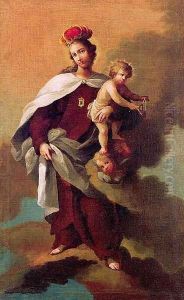Rafael Jimeno y Planes Paintings
Rafael Jimeno y Planes was a Spanish painter and engraver born on August 27, 1778, in Valencia, Spain. He was a prominent figure in the Spanish art world during the late 18th and early 19th centuries and is known for his contributions to Neoclassicism. His work is characterized by its adherence to the aesthetic principles of classical art, with an emphasis on harmony, proportion, and the use of mythological and historical subject matter.
Jimeno y Planes received his early training in his hometown at the Academy of San Carlos in Valencia, where he was influenced by the teachings of the director, José Camarón Bonanat. He honed his skills as a draftsman and painter, excelling in both religious and historical compositions. In 1802, he won a scholarship to study in Rome, which allowed him to immerse himself in the study of ancient art and the works of the Renaissance masters. This experience greatly influenced his artistic development and reinforced his commitment to the Neoclassical style.
During his time in Italy, Jimeno y Planes became associated with other Spanish artists, including Vicente López Portaña and José de Madrazo, who were also instrumental in the dissemination of Neoclassical ideals in Spain. After returning to Spain, he worked on various commissions and became a professor at the Academy of San Carlos in Valencia. His influence on the next generation of Spanish artists was considerable, and he played a key role in the transition of Spanish art from the Rococo to the Neoclassical style.
Throughout his career, Jimeno y Planes produced a significant body of work, including paintings, engravings, and illustrations. His engravings, in particular, were highly regarded and contributed to the spread of Neoclassical aesthetics. Some of his notable works include 'The Miracle of the Well' and 'The Martyrdom of Saint Pelagius.'
Rafael Jimeno y Planes passed away on November 20, 1856, in Valencia. Although not as widely known today as some of his contemporaries, his legacy as a teacher and artist remains an important part of the history of Spanish Neoclassicism. His works are preserved in various museums and collections, attesting to his skill and dedication to the Neoclassical movement.
